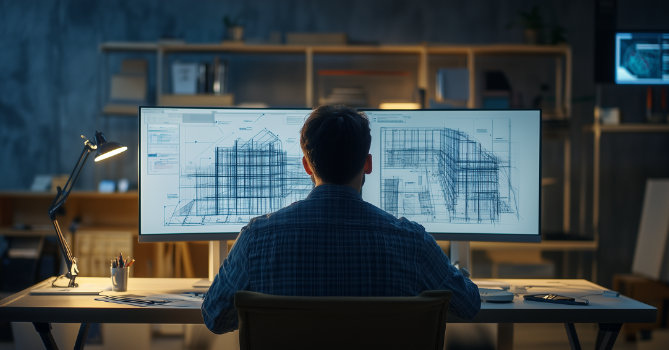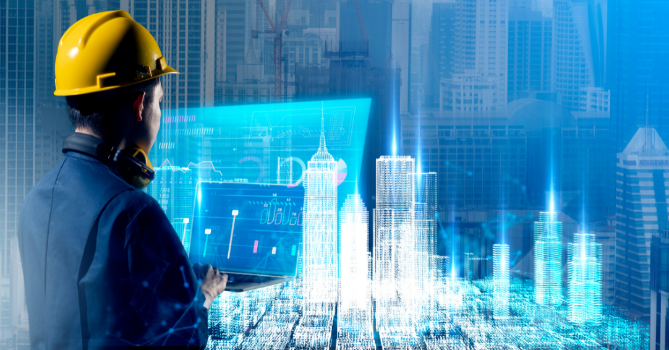.png)
AI-Driven BIM: The Next Big Thing in Construction Technology
Building Information Modeling (BIM) is a digital process that creates and manages data for construction projects. It provides a detailed 3D model that represents the physical and functional aspects of a building. BIM is widely used in the construction industry to improve collaboration, streamline workflows, and enhance project outcomes.
Recently, Artificial Intelligence (AI) has emerged as a powerful tool in the BIM space. AI is transforming how we approach design, construction, and building management. By analyzing large amounts of data, AI can predict potential issues, optimize designs, and automate routine tasks. This results in more efficient, accurate, and cost-effective projects.
The potential for AI to revolutionize BIM is enormous. It could lead to smarter buildings, faster construction, and better resource management. AI-powered tools could reduce project delays by up to 20%, making the construction process smoother and more predictable. As AI continues to evolve, its impact on BIM will likely grow, offering exciting new possibilities for the future of construction.
The Role of AI in Enhancing BIM Capabilities
AI is seamlessly integrating with BIM to enhance its capabilities. One of the key improvements AI brings to BIM is in data processing. By analyzing vast amounts of data, AI helps detect patterns and insights that humans might miss. This leads to more informed decision-making and reduces the likelihood of errors.

Another significant area where AI adds value is in design optimization. AI algorithms can generate multiple design options in a fraction of the time it would take a human. This process, known as generative design, allows architects and engineers to explore a wider range of possibilities, leading to more innovative and efficient designs.
Predictive analytics is another powerful tool that AI introduces to BIM. By predicting potential issues before they arise, AI helps keep projects on track and within budget. For example, AI can forecast delays based on historical data, allowing teams to take proactive measures.
AI-driven innovations are already making a tangible impact on the industry. Case studies show that using AI in BIM has led to enhanced design quality and faster project delivery. AI can significantly improve project timelines by optimizing workflows and reducing manual tasks. As AI continues to evolve, its role in enhancing BIM will likely become even more critical, paving the way for smarter, more efficient construction projects.
Impact on Construction and Design
AI-powered BIM tools are reshaping how we approach construction and building design. These tools streamline construction processes by improving accuracy and reducing the chances of errors. For instance, AI can analyze building data to predict the most efficient way to use materials, leading to optimized supply chains and reduced waste.
One of the most significant impacts of AI in construction is improved energy efficiency. AI algorithms can analyze a building's design and suggest changes that make it more energy-efficient. This not only lowers the building’s environmental impact but also reduces long-term operational costs.

AI also plays a crucial role in better lifecycle asset management. By tracking the condition of a building over time, AI can predict when maintenance is needed, preventing costly repairs. Predictive maintenance is a game-changer, as it allows for timely interventions before problems escalate.
Real-world examples highlight the benefits of AI in construction. For instance, some projects have used AI to manage risk by identifying potential safety hazards before they occur, leading to safer work environments and fewer accidents. AI integration in construction has led to reduced costs and enhanced project outcomes, making it a valuable tool for the industry.
Challenges and Ethical Considerations
While AI brings many benefits to BIM, it also presents challenges and ethical concerns. One major issue is data security. With AI handling vast amounts of sensitive information, there's a risk of data breaches. Protecting this data is crucial, especially in construction projects where confidential details are involved.
Another concern is technological dependence. As AI becomes more integrated into BIM, there's a risk that the industry could become too reliant on these systems. This could lead to problems if the technology fails or if skilled workers lose touch with traditional methods.
Job displacement is also a significant worry. As AI automates more tasks, there’s a fear that jobs could be lost. However, it's important to note that while AI might change certain roles, it also creates new opportunities for workers to engage in more complex, less repetitive tasks.
Balancing innovation with ethical responsibility is key. Industry bodies are developing guidelines to ensure that AI is adopted responsibly in BIM, emphasizing data protection and the need for continuous human oversight. These initiatives aim to address the challenges while maximizing the benefits of AI in the construction industry.
The Future of AI-BIM Integration
The future of AI-BIM integration is set to be transformative. As AI continues to evolve, we can expect it to bring even more automation and intelligence to BIM processes. One key trend will be the increased use of machine learning algorithms that can learn from past projects and improve decision-making over time. This will lead to more accurate predictions, better resource management, and smarter designs.
Automation will also play a larger role. Tasks that are currently time-consuming, such as clash detection and quantity takeoffs, could become fully automated, allowing teams to focus on more strategic aspects of their projects. AI will also enhance real-time collaboration, enabling teams to work together more efficiently, regardless of location.

Looking ahead, AI-driven BIM is likely to lead to more sustainable construction practices. By optimizing designs for energy efficiency and resource use, AI can help reduce the environmental impact of buildings. Ongoing research into AI and BIM will likely lead to innovations that make construction not only faster and cheaper but also greener.
Industry experts agree that the integration of AI with BIM will continue to push the boundaries of what’s possible in construction. As these technologies advance, the construction industry is poised to become smarter, more efficient, and more sustainable, setting the stage for a new era in building design and management.
Conclusion
AI is transforming the BIM industry, driving innovation and efficiency across construction and design processes. By enhancing data processing, optimizing designs, and predicting potential issues, AI-powered BIM tools are making projects more accurate and cost-effective. While challenges like data security and job displacement need careful consideration, the benefits of AI in BIM are undeniable.
Looking ahead, the integration of AI and BIM promises a future of smarter, more sustainable construction practices. As AI continues to evolve, industry professionals should embrace these technologies to stay ahead. AI could reduce project delays by up to 20%, underscoring its potential to revolutionize the industry. The future of construction lies in AI-driven BIM, and adopting these innovations will be key to building more efficient, sustainable, and successful projects.